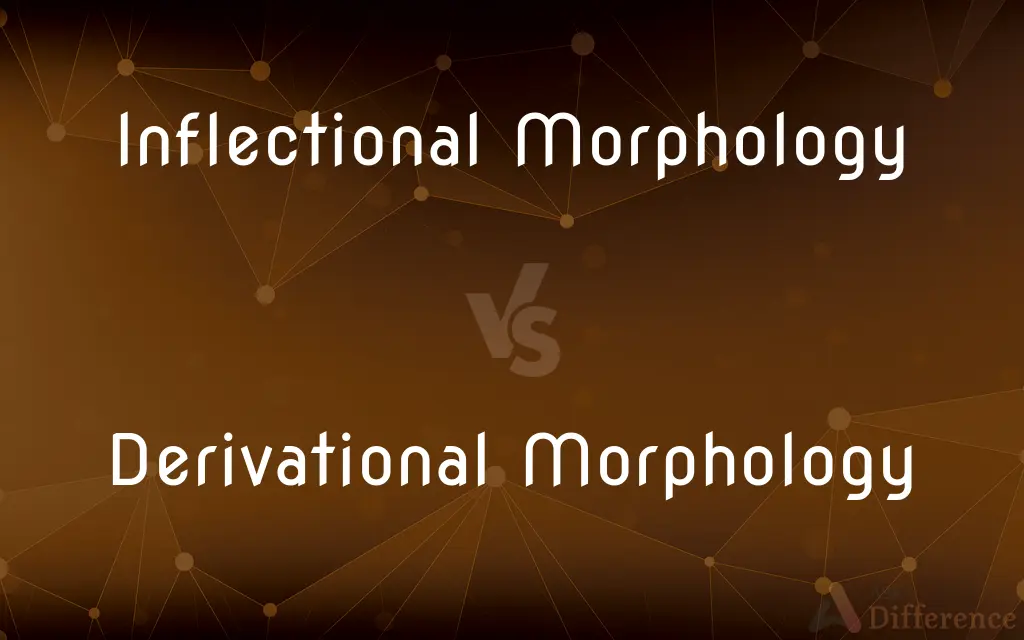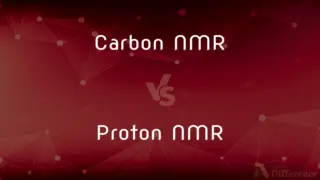Inflectional Morphology vs. Derivational Morphology — What's the Difference?
By Tayyaba Rehman — Published on November 14, 2023
Inflectional Morphology modifies a word's form to fit grammatical contexts. Derivational Morphology creates new words by adding prefixes or suffixes.

Difference Between Inflectional Morphology and Derivational Morphology
Table of Contents
ADVERTISEMENT
Key Differences
Inflectional Morphology deals with the modifications made to words to convey specific grammatical information, ensuring that they fit into their respective syntactic roles within a sentence. Conversely, Derivational Morphology is concerned with the formation of new words by adding affixes (prefixes, suffixes, etc.) to base words.
The primary function of Inflectional Morphology is to mark properties such as tense, case, number, or gender. It doesn't change a word's basic meaning or its word class. In contrast, Derivational Morphology can change the grammatical category of a word. For example, by adding an affix, a verb can become a noun or an adjective can transform into an adverb.
A critical distinction between Inflectional Morphology and Derivational Morphology is the number of affixes a language possesses for each. Generally, there are fewer inflectional affixes than derivational ones. This is because inflectional affixes have a more limited set of grammatical functions to cover, while derivational affixes can create a myriad of new words with varied meanings.
Inflectional Morphology does not typically change the basic meaning or "lexeme" of a word. It adjusts the word to express various grammatical relations. On the other hand, Derivational Morphology creates entirely new lexemes, expanding a language's vocabulary and allowing for more nuanced expression.
While both Inflectional Morphology and Derivational Morphology play critical roles in language structure and development, their purposes are distinctly different: one is for grammatical adaptation, and the other is for vocabulary expansion.
ADVERTISEMENT
Comparison Chart
Purpose
Conveys grammatical information.
Forms new words.
Changes to...
Word's form.
Word's meaning and/or part of speech.
Number of Affixes
Typically fewer.
Typically more.
Affects
Same lexeme.
Creates new lexemes.
Example
Adding -s to indicate plurality (e.g., cat/cats).
Adding -ness to form a noun (e.g., happy/happiness).
Compare with Definitions
Inflectional Morphology
It doesn't change the base meaning of a word.
Jumped still refers to the action of jumping, showcasing Inflectional Morphology.
Derivational Morphology
It's key to vocabulary expansion in languages.
Direct evolves into direction via Derivational Morphology.
Inflectional Morphology
Inflectional Morphology adjusts words for syntactic fit.
The quickest runner uses Inflectional Morphology to form the superlative quickest.
Derivational Morphology
It can change the word's grammatical category.
Act turns into actor through Derivational Morphology.
Inflectional Morphology
Inflectional Morphology alters a word to express grammatical nuances.
She writes uses Inflectional Morphology to show third person singular.
Derivational Morphology
Derivational Morphology forms new words through affixation.
Kind becomes kindness using Derivational Morphology.
Inflectional Morphology
It indicates properties like tense, number, and gender.
She speaks employs Inflectional Morphology for present tense.
Derivational Morphology
Derivational Morphology often affects a word's core meaning.
Play becomes player using Derivational Morphology.
Inflectional Morphology
Inflectional Morphology is integral for sentence agreement.
They are vs. He is demonstrates Inflectional Morphology in action.
Derivational Morphology
Derivational Morphology enriches vocabulary by creating varied meanings.
Joy transforms into joyful using Derivational Morphology.
Common Curiosities
Can you give an example of Inflectional Morphology?
Yes, turning "run" into "runs" to indicate third person singular.
What's a Derivational Morphology example?
Turning "beauty" into "beautiful" by adding the suffix "-ful."
How does Derivational Morphology impact a word?
It forms new words, potentially changing their meaning or grammatical category.
Is "unhappiness" an example of Derivational Morphology?
Yes, it has the derivational prefixes "un-" and suffix "-ness."
Are tense markers a part of Inflectional Morphology?
Yes, they indicate different tenses without changing the word's basic meaning.
How many inflectional morphemes does English have?
English has eight primary inflectional morphemes.
Is "singer" an example of Derivational Morphology?
Yes, the "-er" suffix creates a noun from the verb "sing."
What does Inflectional Morphology deal with?
It modifies words for grammatical contexts without changing their core meaning.
Can Derivational Morphology change a verb to a noun?
Yes, like "play" to "player."
What's the primary goal of Derivational Morphology?
To expand vocabulary by creating new words.
Does Inflectional Morphology change a word's class?
No, it maintains the word's grammatical category.
Do languages have more derivational or inflectional morphemes?
Typically, languages have more derivational morphemes.
Can you explain plural morphemes in Inflectional Morphology?
They adjust nouns to indicate more than one, like "cat" to "cats."
Can Inflectional Morphology affect a word's spelling?
Sometimes, as with "write" changing to "wrote" for past tense.
Can Derivational Morphology make words negative?
Yes, prefixes like "un-" or "in-" can add negative meanings.
Share Your Discovery

Previous Comparison
Carbon NMR vs. Proton NMR
Next Comparison
Eagle vs. VulturAuthor Spotlight
Written by
Tayyaba RehmanTayyaba Rehman is a distinguished writer, currently serving as a primary contributor to askdifference.com. As a researcher in semantics and etymology, Tayyaba's passion for the complexity of languages and their distinctions has found a perfect home on the platform. Tayyaba delves into the intricacies of language, distinguishing between commonly confused words and phrases, thereby providing clarity for readers worldwide.














































